This article was published in Scientific American’s former blog network and reflects the views of the author, not necessarily those of Scientific American
And so I find myself at the stage in my life and career where it feels somehow appropriate to look at – and review – the adventures and publications of the dim and distant past. Today, I’m an experienced author with over 10 books to my name. All the books I’ve been involved in have interesting backstories – well, interesting to me, anyway – and in recent months I’ve had cause to write down recollections of those backstories for a larger project. Here, we look at the making of a book I co-authored with my former PhD supervisor David Martill back in 2000 and 2001: Dinosaurs of the Isle of Wight (Martill & Naish 2001). Dinosaurs of the Isle of Wight was (mostly) well received when it came out and seems to have been both inspirational and useful to the sort of people we’d imagined reading and using it. It’s now very much out of print and also quite hard to get, on which more below.
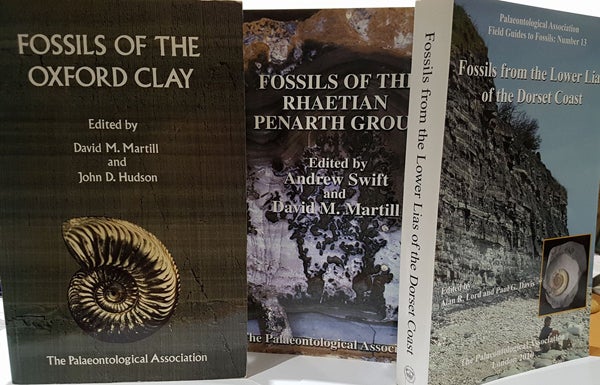
A few – just a few – volumes from the highly successful Pal Ass Field Guide to Fossils series. The Oxford Clay and Penarth Group volumes pre-date Dinosaurs of the Isle of Wight; the Lower Lias volume is from 2010. We’re still waiting for the Kimmeridge Clay volume. Credit: Darren Naish
During the year 2000 I was studying for my PhD at the University of Portsmouth, and was thus mostly occupied (as and when possible) with the theropod dinosaurs of the English Lower Cretaceous Wealden Supergroup, Eotyrannus in particular. But other things were happening at the same time, and among those things was the delivery of content needed for the soon-to-open Dinosaur Isle museum on the Isle of Wight, which I was producing with Dave.
On supporting science journalism
If you're enjoying this article, consider supporting our award-winning journalism by subscribing. By purchasing a subscription you are helping to ensure the future of impactful stories about the discoveries and ideas shaping our world today.
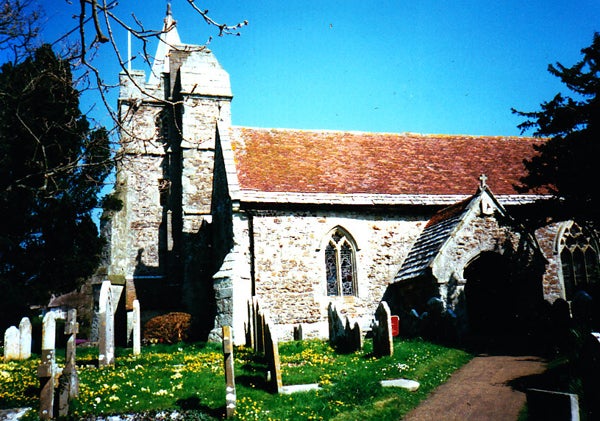
Dave and I visited various historical locations relevant to Isle of Wight dinosaurs during our quest for things relevant to the book. We went here: the church in Brighstone, Isle of Wight, where the Reverend Fox (collector of several Isle of Wight dinosaurs taxa) was curate, and is buried. Credit: Darren Naish
Anyway... the plan was for a book to appear in time for the museum’s opening, a job that had initially been given to Steve Hutt of the Isle of Wight County Museums Service (one of the main drivers behind the creation of Dinosaur Isle). But Steve needed help and had gone to Dave. Dave and I were deep in the world of Wealden dinosaurs at this point (in part because of on-going work on Eotyrannus, Neovenator and other theropods), so Dave made the decision to bring me in too. Through his good contacts with the Palaeontological Association (known for short as the Pal Ass... deduct ten points if you think this amusing or find yourself recalling Stephen Jay Gould’s comments), Dave was also able to set up the publication of the resulting work as part of the Pal Ass Field Guide Series (he had previously produced three other volumes in the series, all of which had been successful). This meant that the work would be a technical, monograph-style book and that we wouldn’t ever see any money. Because I’m an idiot who does things because I think they’re worthy, rather than what I’ll get out of them, this never bothered me at all, and so off to work we went. It would have to be turned around pretty quickly if we were have it published in time for the new museum’s opening.
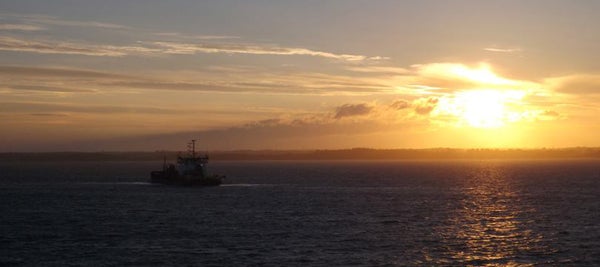
If you live on the English mainland aaaand if you want to get to the Isle of Wight, you’d better like using ferries. A Solent scene from June 2013. I have spent hours and hours and hours on these ships. Credit: Darren Naish
The initial plan was for the entire volume to be ‘Martill and Naish’. However, the chapters vary as goes author contributions and we also had reason to bring in additional authors on some of the chapters. We also wanted Steve to remain involved given that the project was his in the first place. By the time we were about 50% of the way through, we decided that the best option was to give each chapter a different authorship, the whole volume being ‘edited’ by Martill and Naish. This seemed fair, so long as people cite individual chapters as and when appropriate.
As things progressed, the volume expanded into a vast, time-sapping project. Dave and I spent days and days writing the text, often at his home on the Isle of Wight. I have fond memories of racing, late at night, to get the last ferry home to the mainland – and then missing it and having to wait for hours for the next one. We made innumerable museum trips and field trips to relevant historic sites, and also visited numerous private collections on the Isle of Wight, often seeing material that would be revisited in later work (among it, the ‘Angloposeidon’ specimen and a notorious small theropod still in private hands).
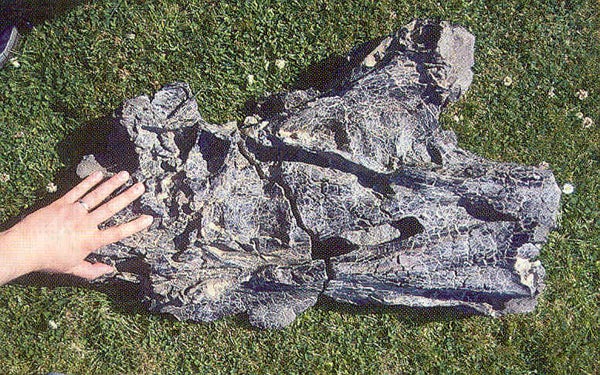
The colour photo we took of the better of the ‘Angloposeidon’ cervical vertebrae after encountering it at the late Dave Cooper’s house (where he was preparing it). This exact photo features in the colour plate section of Dinosaurs of the Isle of Wight. The specimen was later the focus of a short technical paper. Credit: Martill & Naish 2001
As anyone familiar with the British dinosaur literature will know, the species discovered and described here during Victorian times are all too frequently embroiled in what can best be described as hideously complex taxonomic messes. We tried (and sometimes failed) to resolve various of these; I had substantial help from Paul Barrett on some aspects of Wealden sauropod taxonomy, and – my bad – don’t feel that he was acknowledged appropriately for that help. The decision was made to include a chapter on pterosaurs. During the late 1990s and early 2000s, ‘everyone knew’ that the Wealden pterosaur formerly known as Ornithodesmus needed a new name (as demonstrated by Howse & Milner (1993), it turned out that the type material attached to this name was not from a pterosaur as previously thought, but from a maniraptoran theropod instead) and that pterosaur worker Stafford Howse had one waiting in the wings, so to speak. Due to my work as a technical editor for Elsevier (and that’s a whole ‘nother story), I’d been corresponding with Howse, so I made contact once more. The result: a pterosaur chapter that includes the new name Istiodactylus and the publication of a brand-new life reconstruction that Stafford had produced but not previously used (Howse et al. 2001).
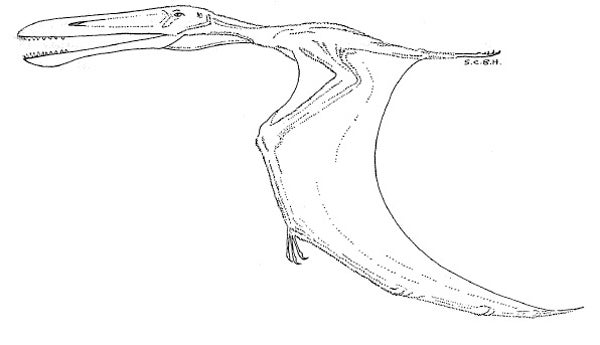
Stafford Howse’s life reconstruction of Istiodactylus latidens. Much work on istiodactylid pterosaurs has been published since the 2001 appearance of the relevant chapter in Dinosaurs of the Isle of Wight: I. latidens itself has been reappraised by Mark Witton, and new taxa from China have been described by Brian Andres and colleagues, Xiaolin Wang and colleagues, and others. Credit: Howse et al. 2001
Most of the photos that feature in the book were taken by Dave and our then-technician at the university, Bob Loveridge, on trips to the Natural History Museum (London). I missed out on some of those trips. Indeed, I missed out on so much relevant stuff in those days since I had to spend most days of the week at my paying job. More on that in a moment. Confusion meant that a few specimens photographed in the London collections are incorrectly labelled in the final product, as Peter Galton would later point out, at length. We accidentally have Echinodon (a heterodontosaurid from the Purbeck Limestone Group) in there as a Hypsilophodon jaw, for example. There are other errors in the book too (William Fox is referred to throughout as William D. Fox – a mistake, since W. D. Fox was a different person entirely), but such is par for the course in a giant, complex project... especially one turned around in an incredible hurry (recall that we were rushing to complete the book so that it would be published before the new Dinosaur Isle museum opened).
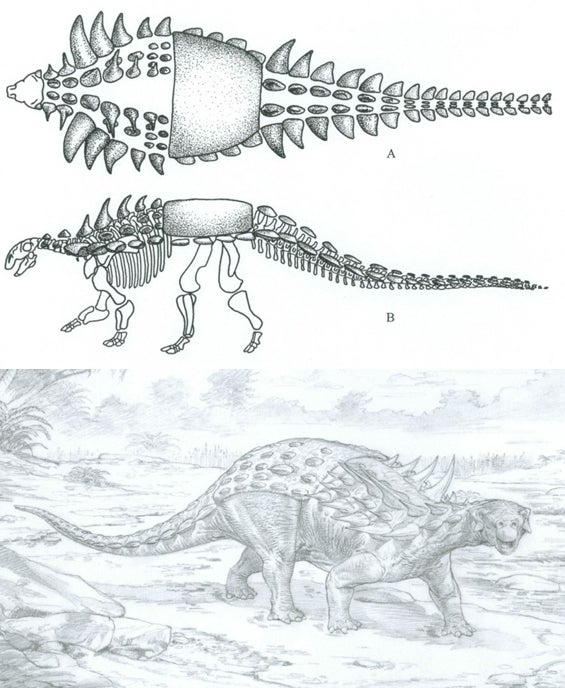
Material from various artists included in Dinosaurs of the Isle of Wight. Here, from the thyreophoran chapter (Naish & Martill 2001a), we have (at top) Tracy Ford’s reconstruction of Gastonia and (below) John Sibbick’s Polacanthus. Sibbick’s pencil drawing here is a prototype of a colour painting that has since appeared elsewhere (including the cover of the Bill Blows’ book on polacanthids). Credit: Naish & Martill 2001a
A vast number of diagrams were compiled, mostly by Stig Walsh. Dave and I also thought it appropriate that the book be prettied up with a selection of colour plates and Dave’s idea was that we get a bunch of palaeoart from (.... drumroll...) John Sibbick, who Dave already knew from previous collaboration. So, we went to John’s house in Bath (today he lives on the Isle of Wight, appropriately enough). Somehow, Dave managed to convince John to give us a bunch of work for free... which is not ok, but happened anyway.
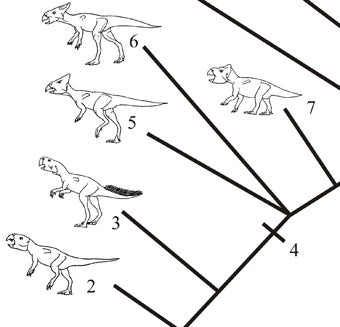
A section of the ceratopsian cladogram from Naish & Martill (2001b)... yeah, there’s a section in there on ceratopsians. Anyway – spot the quill-tailed psittacosaur. Credit: Naish & Martill 2001b
I should also mention the fact that – thanks to secret knowledge I had acquired via Luis Rey – I included an illustration of a psittacosaur with tail quills. When the book came out, this was the first time such a thing had been shown; some journalists knew what was going on, and were sniffing around for a story on the specimen concerned. A science journalist based at a well-known science journal devoted to science contacted me for comment (a big deal to me at the time) BUT, again, my intermittent time spent at university (no internet access at home in those days!) meant that I missed out (Stokstad 2001). I also pulled favours and got illustrations by Tracy Ford and Luis into the book. And what about the cover? Julian Hume – extinct bird expert and artist – was also based at Portsmouth at the time (we occupied adjacent offices), and Dave commissioned him to knock something up.
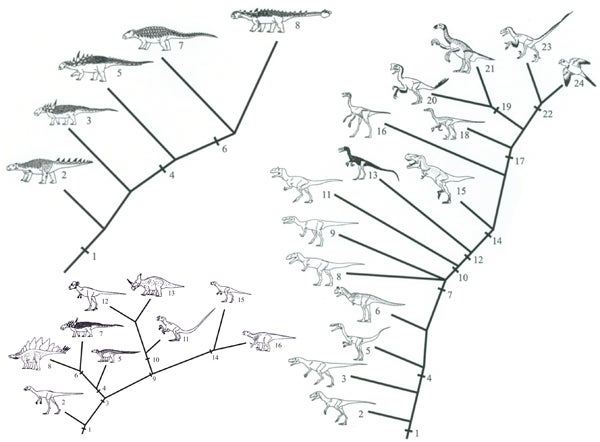
Dinosaurs of the Isle of Wight includes a fair assortment of cladograms. Naturally, they’re a bit dated now, and the formats we went for look a bit quirky. You might guess who did all those little drawings. Credit: Martill & Naish 2001
Anyway… the problem with producing a semi-technical monograph-style work is that the only constraint is your own time and thoroughness, and I wanted to be thorough. So, the project ballooned into a monster because I wanted to cover everything (causing one reviewer to complain that the book was just too big, that it tries to do too much). It was the biggest Field Guide manuscript the Pal Ass had ever received, and – on Thursday 8th March, 2001 – I bundled it up in a box – with the original photographic plates and everything – and mailed it off. Yes, this was the time when everything was submitted in hard copy. Proofs, copyright assignment forms and so on were dealt with by the end of May 2001… all of which was happening at the exact same time as Eotyrannus was being published (Hutt et al. 2001), as the giant Dorling Kindersley book Encyclopedia of Dinosaurs and Prehistoric Life (Lambert et al. 2001) was being finalised and as I was moving house. Oh, and we began filming for the live TV series Live From Dinosaur Island at the start of June, a project with links to everything discussed here (except my moving house).
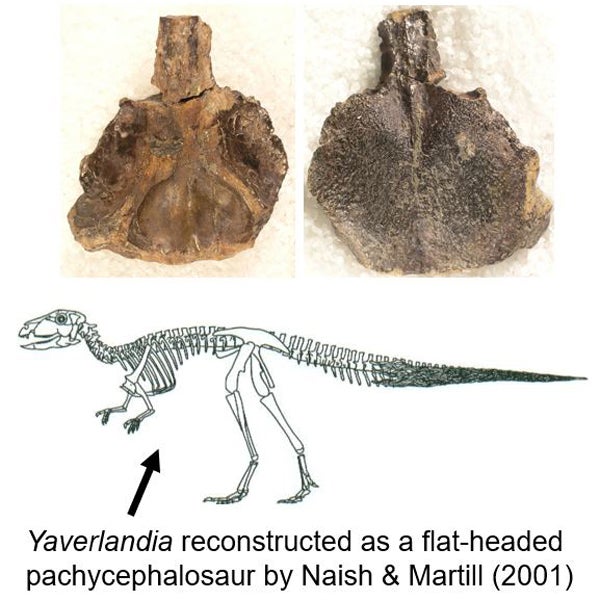
There’s a bunch of stuff in Dinosaurs of the Isle of Wight that is now very likely wrong, some of which needs revisiting. We have Yaverlandia as a pachycephalosaur and even featured a gratuitous skeletal reconstruction of it as such. Oops. One day I’ll publish the reappraisal of Yaverlandia I produced for my PhD thesis. Credit: Darren Naish
I finally got to see and handle the published volume in July – in fact, a copy was handed to me on the street (by Dave) just as I was returning from an (unsuccessful) museum-themed job interview on the Isle of Wight. At 433 pages, the final volume is huge. But it was insanely affordable for its size – just £16 – and immediately sold well. Indeed, last I heard, it was exponentially more successful (in terms of number of sales) than any other volume in the series. Remember that we got not a single penny for this volume. Today, it sells for quite a lot. I only own a single, battered copy (now marked with lots of pencilled annotations). Many people said kind things about it, which I appreciate, and I think it includes a lot of stuff that isn’t covered elsewhere (as goes books – rather than technical papers – anyway). Did we succeed in getting it published in time for the opening of Dinosaur Isle museum? Yes: Dinosaur Isle’s official opening was on Thursday 30th September 2001 (an event I had to miss due to being in exotic Weston-Super-Mare at the time). Mission accomplished.
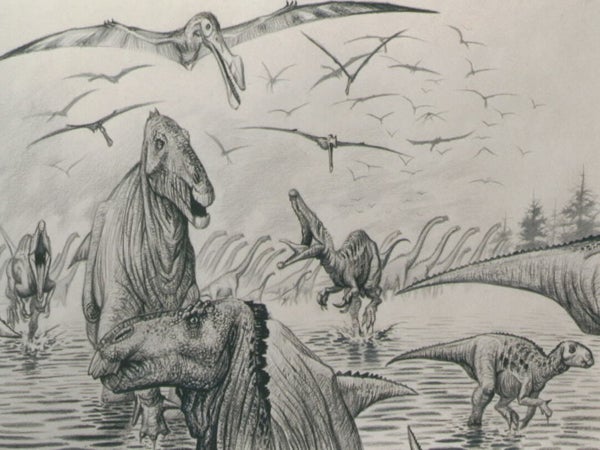
A Wealden scene that Luis Rey allowed us to use in the book (where it appears as the frontispiece). Iguanodon, territorial baryonychines, a brachiosaurid herd, and Coloborhynchus-type pterosaurs. Credit: Luis Rey, in Martill & Naish 2001
There has, for some time, been the idea that a 2nd edition of Dinosaurs of the Isle of Wight should appear. Indiana University Press were interested in this at one point and invited me to submit a proposal, but this invitation had been forgotten when I actually got round to submitting it. I’ve also been in dialogue with the Pal Ass on the prospect of producing a 2nd edition, but the fact that I cannot possibly do it for free is a deal-breaker and no progress has been made. I’m constantly in quest of new copies of Dinosaurs of the Isle of Wight today but never see it on sale at a reasonable price, and the Pal Ass sold all of its stock some years ago. So, if you don’t already own one, you’re perhaps unlikely to ever do so.

The only copies of Dinosaurs of the Isle of Wight you might see on sale today... ugh, expensive. This is a screen-grab from amazon, taken on 12th April 2018. Credit: amazon
A shorter, slightly different version of this article previously appeared on the Tetrapod Zoology facebook page and at my patreon. If you thought it at all worthy or interesting, let me know and I’ll publish similar ‘back-story’ articles on other books I’ve been involved in. If you thought it trite or boring, why are you still here?
For previous Tet Zoo articles on Wealden dinosaurs, see...
My dinosaur colouring book # 2 (Wessex Formation dinosaurs)
Concavenator: an incredible allosauroid with a weird sail (or hump)... and proto-feathers?
The explosion of Iguanodon, part 2: Iguanodontians of the Hastings Group
Refs –
Howse, S. C. B. & Milner, A. R. 1993. Ornithodesmus - a maniraptoran theropod dinosaur from the Lower Cretaceous of the Isle of Wight, England. Palaeontology 36, 425-37.
Howse, S. C. B., Milner, A. R. & Martill, D. M. 2001. Pterosaurs. In Martill, D. M. & Naish, D. 2001. Dinosaurs of the Isle of Wight. The Palaeontological Association, London, pp. 324-335.
Hutt, S., Naish, D., Martill, D. M., Barker, M. J. & Newbery, P. 2001. A preliminary account of a new tyrannosauroid theropod from the Wessex Formation (Early Cretaceous) of southern England. Cretaceous Research 22, 227-242.
Naish, D. & Martill, D. M. 2001b. Boneheads and horned dinosaurs. In Martill, D. M. & Naish, D. 2001. Dinosaurs of the Isle of Wight. The Palaeontological Association, London, pp. 133-146.
Naish, D. & Martill, D. M. 2001a. Armoured dinosaurs: thyreophorans. In Martill, D. M. & Naish, D. 2001. Dinosaurs of the Isle of Wight. The Palaeontological Association, London, pp. 147-184.
Stokstad, E. 2001. Mysterious e-photos vex palaeontologists. Science 293, 1573.